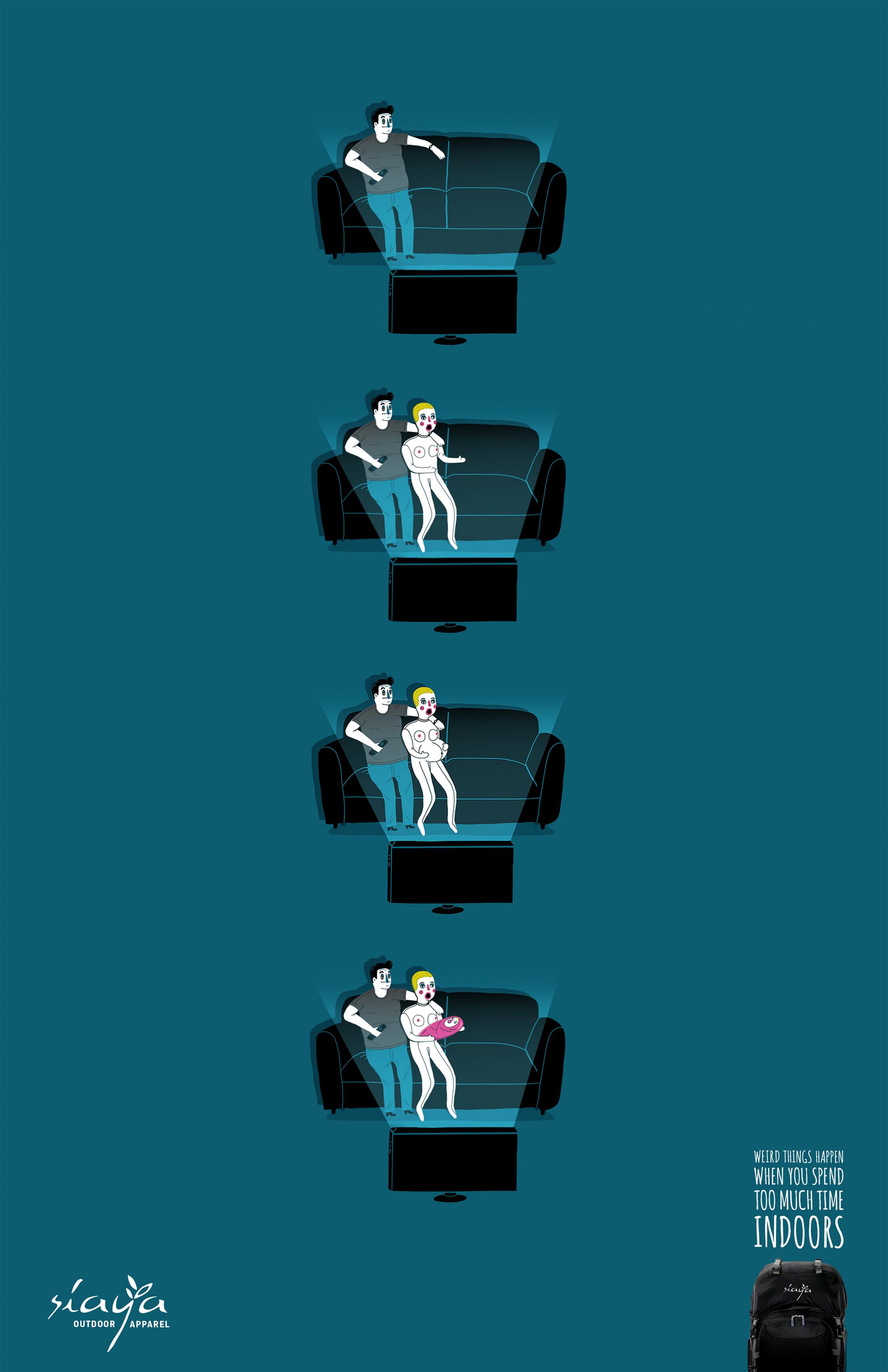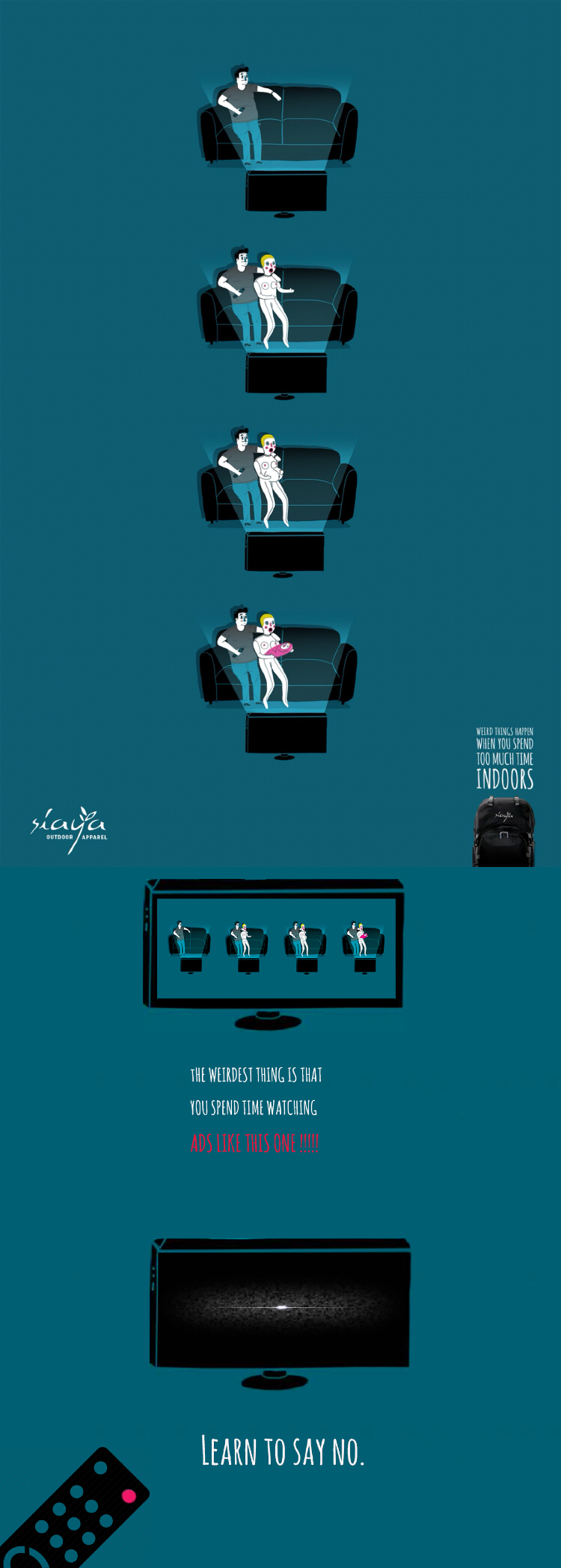
The original advertisement poster for Siaya Outdoor Apparel
The advertisement designed for an outdoor apparel brand conveys manifold messages pertaining to gender, sex, and sexuality, all of which are unexceptionally problematic and disturbing.
The sexual objectification of women is highly salient in the commercial. The female character is portrayed as a sex-doll from a voyeuristic male gaze, with a weird face reminding the audience of Billy, the puppet featured in the American horror Saw franchise, and with her breasts exposed in order to absurdly displaying her femininity. In the last two vignettes, pregnancy and motherhood reinforce the stereotypical projection of women as nothing more than a reproductive machine.
The sexist and heteronormative ideology regarding family and sexuality is insulting as well. The chronologic representation of family formation views the male character as the hard core of a family, that is, his very presence is the precondition of family construction: the man is alone in the first vignette, watching TV on a couch, while his wife and son appear latter as supplementary elements having little influences on the man (as could be deducted from his constant facial expression). When a closer look is taken at the advertisement, an unequal power dynamic between the two genders becomes prominent. With his arm surrounding the woman’s shoulder, the man is depicted as a protector of his wife. On the contrary, the latter leans towards her husband, reproducing the image of a submissive, dependent wife within the heterosexual discourse. In regard to both characters’ parenting roles, people will easily notice the binary representation of distant father/nurturing mother in the last picture where it is, not surprisingly, the mother who carries the baby in her arms.
The advertisement is by nature sexist also because it is exclusively targeted at male customers, attempting to build an artificial link between gender and particular attributes like being sportive. The slogan “weird things happen when too much time spend indoor” appeal particularly to “you” to buy outdoor apparels such as a hiking backpack. Here, it is apparent that this “you” refers to men identifying themselves as couch potato husbands leading a boring life with a boring wife, just like the male character in the poster. Women are therefore reduced to an inferior position where they are considered as illegitimate for sports activities.

My jammed version of the ad
Considering that this advertisement manifests so many problematic ideologies that it is almost impossible to fix all of them within its original framework, I made the jammed version into a funny parody of it, turning what has been depicted as reality into something virtual and intangible, something only existing in the tiny screen of the TV.
Specifically, I deconstruct the absurd “reality” explored in the former copy by revealing its commercialized essence. In my slogan “the weirdest thing is that you spend time watching ads like this”, I remind people to be aware of the fact that what the media presents is not even the partial truth of life but distorted images and biased knowledge. It also challenges the perception that stigmatizes marriage, reproduction, and family as something undesirable and “weird”. I ironically adopt the superlative form of the adjective “weird” in my new slogan to show how ridiculous it is for people to produce, disseminate and internalize problematic beliefs concerning gender and sexuality through allegedly valid ways like advertising campaigns.
Additionally, I enlarge the coverage of this advertisement to include more groups and communities. Though I use the same second person pronoun “you” in my extended vignettes, it does not refer solely to one gender or sex. In fact, my jammed version endeavors to insinuate a more critical perspective among the general public who are constantly under influences of and controls from the mass media.
The last image features an invisible subject turning off the TV with a remote control, and a short yet powerful sentence that reads: “Learn to say no”. This is meant to urge the public to be more agentive in face of prevailing ideologies that is marginalizing and limiting in distinctive ways. Despite the fact that both advertisements end up encouraging people to spend less time in front of the TV, mine version models how to resist powerful discourses imposed upon the audience while the old one socializes them to either buy a product or an ideology.
